#i feel like it’s giving those 2012 watercolour paintings and i’m
Explore tagged Tumblr posts
Text

‘And the shame, was on the other side’
Byler Valentine’s day 2025 🩵💛 not my usual style but something a little bit glowy & sketchy with pearlescent watercolour
#byler#stranger things#mike wheeler#will byers#byler target audience#byler art#fanart#flickergate#kinda#i feel like it’s giving those 2012 watercolour paintings and i’m#but i’m always overly critical#gouache#metallic watercolour#sketch#byler kiss#valentines 2025
166 notes
·
View notes
Text
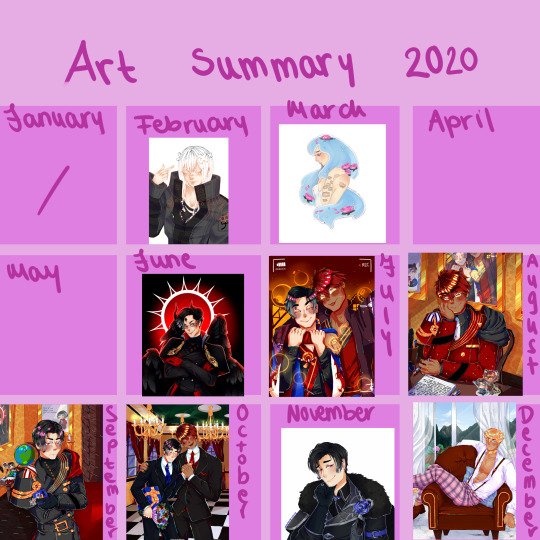
I finally made one of those again, and I wanted to share and actually tell you the whole story of my art since this is actually my 10th year of drawing, believe me or not :3 This is also actually the biggest audience I ever had and I’m so grateful for all of you, and for Obey Me! to stumble into my life because, you will see, I completely lost motivation and any ideas to actually draw in the years prior. I am so grateful for all that’s happened, and thank you for being here with me! I found friends here again that I wouldn’t give up for anything, they make me feel better about myself and what I do and I’m gonna cry on you. I love you ;A; Feel free to read through the rest I put them under the cut. But I’m really proud of what I achieved that year. I finally found my love for drawing again. DiaLuci gives me serotonin, I made some OCs that I love and that are the most detailed I ever made. And I also drew the most detailed pics I ever made, you can see under the cut how little backgrounds I drew, and now looking at this, I made one extremely detailed one each month. I had to figure out a style I enjoy again, which I luckily did, but I also still like to experiment and not stick to one thing, but I enjoyed trying out new stuff! I put more effort and detail in again, and I really hope I will keep this up even when I start work, I really hope I will! I’d be sad. I finally enjoy this again, I finally have ideas again. I’m feeling so much better, so thank you all for that!

I fist started drawing in 2011, when I was 12. I started since I joined the warriors fandom as my aunt gifted me one of the books and they had a like to an online forum that was handled by the publisher. So I signed up there with my parents permission obviousely. Don’t let any 12 year olds on other sites, thank you. I joined DeviantART when I was 13 and allowed to. I’m a good kid. But anyways, I drew a lot of animals, mostly cats and dogs thanks to that. I also drew a lot in the beginning, so many ideas and I had a few friends that supported me too, it was nice and made me want to keep going.

2012 was the same, and I still think the first few years when you start are the ones you have the highest spike in improvement. Still drew a lot each month, started to draw lots of chibis as well. I never really studied anatomy, only watching a few colouring tutorials. I just wanted to have fun.

I started to get better at colouring this year and started to add lots more datails and spend longer on the drawings, still drew lots and lots.
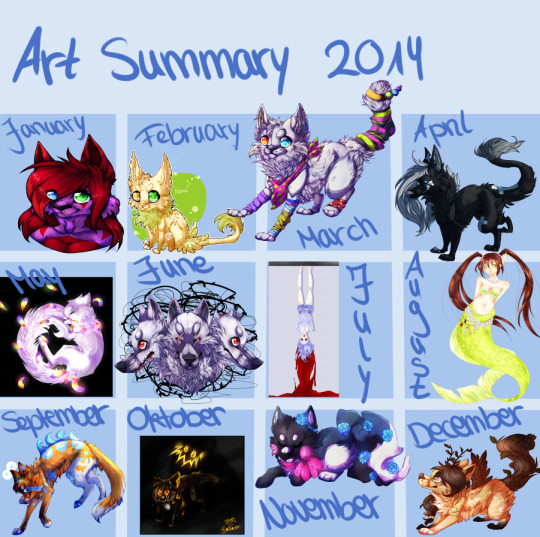
I’m still fully set on 2014 being the best year in my past, especially for colouring. I put so much effort into everything. But this was also the year where it went down. Some things happened online and I just started to lose interest as I left the fandom. I drew less and less, mostly only one-two things each month. Also since I barely had an audience I started to let that get to me which was stupid, I started to think why should I spend hours and hours drawing something none will look at anyways, so I looked for ways to make my colouring more simpler and put in less details again.

This started to be very noticeable in the year after that. I only had one picture to chose from each month, if at all. I just really started to loose motivation, especially with no ideas as to what to draw. Mostly OCs and occasionally some fanart for an anime that I like. Don’t ask me what October is supposed to be it was the only thing I made that month idk.
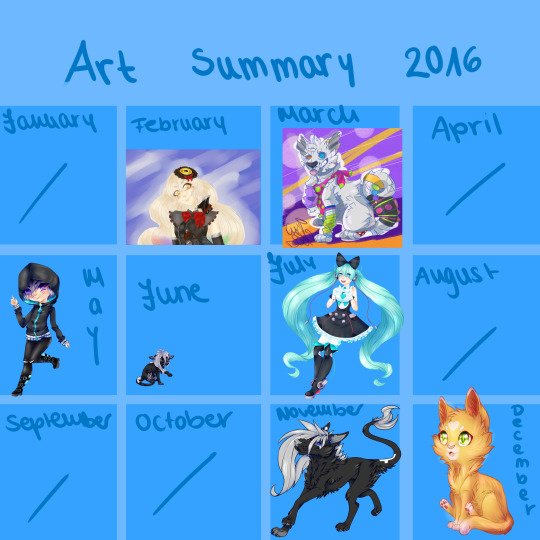
2016 was a really bad year. I just didn’t know what to do with myself and my art anymore. I also started uni so that took some of my time, but not that much, during my holidays between end of school and beginning of Uni from July til October I also didn’t draw much. I only tried a lot of new things, simplifying and not being happy with anything that I made. Aside from November I don’t like any of those pictures. But as I sad, I was just lost and had no ideas anymore, I didn’t feel good about the things I made but I kept going, forcing myself to draw at least once in a while so I don’t completely forget how it works.
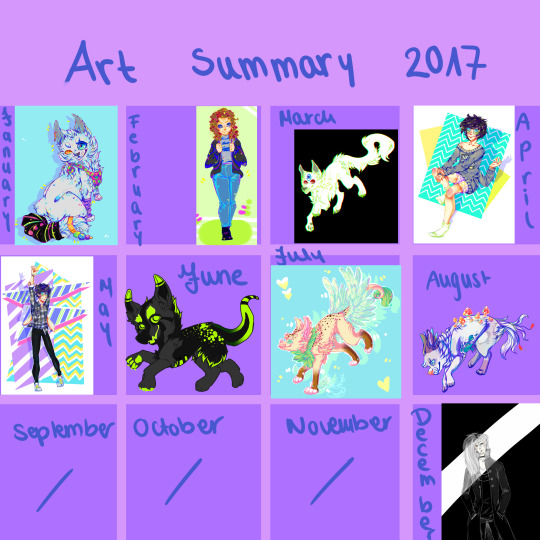
2017 I felt inspired again, making up that extremely colourful style that I adapted now again, it gave me serotonin and at least I liked what I was making again. I drew a lot more in the beginning of the year two, just enjoying slapping colour on everything. But I lost motivation pretty soon, I also felt kind of lonely now that I think about it, I wasn’t super sad but I didn’t really had anyone to talk to, breaking up with my toxic ass friends about half a year before school ended and I didn’t really find anyone in uni that I was close with. I just sat around after classes and watched anime until I dropped to bed pretty early everyday. I’m still proud of my very strict sleeping schedule, that happened mostly because I had no reason to stay up :D But anyways, there are a lot of month, strangely enough my big break months where I didn’t draw at all, I probably was too lazy and exhausted.
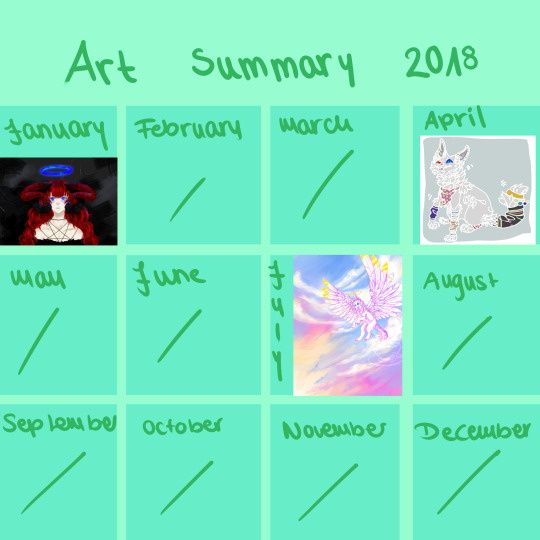
Best. Year. Of. Drawing. Peridot. Outdid myself. Very much art. So good. Had so many ideas, tried three new styles just to go back to the old one for the redraw because I wasn’t happy with them. So much improvement. It’s amazing how much I did that year. Idk. I probably was mentally dead and watched even more anime. Though I also did that in years I drew a lot. Idk.

2019 was a lot better then the year before. I missed drawing but still didn’t have a lot of ideas. But I joined instagram for a short time and there were a lot of these “Draw this in your style” that provided me with ideas, and I really enjoyed doing those. I tried digital painting for the first time then and I’m still super proud of what I did in January. I also tried to work more with watercolour in this year. I spend more time and attention with colouring again, working and changing my style a bit. I still really like what I drew last year! I also have a weird obsession with eyeballs and I can fit three pairs on a face and it still looks okay, can you tell? I didn’t drew much this year but I like the quality I made I guess? Motivation ran out pretty quickly though, and that might be because I also did creative work for university so that could’ve played into it. And now off to 2021 :3
19 notes
·
View notes
Photo
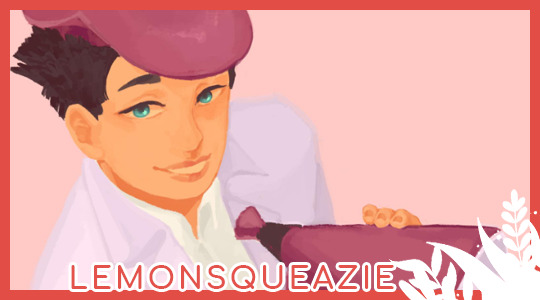
Artist spotlight: LEMONSQUEAZIE!
✿ Ko-fi ✿ Twitter ✿ Tumblr ✿ Youtube
Header source: [X]
Introduce yourself Hi! I'm Lem and I've wanted to try focusing on things other than people in my work for a while now! I'm into deltarune, mystic messenger, and (recently) Moomin! When did you start drawing? Are you a digital or traditional artist? I started drawing seriously in 2012 when a friend got me to learn how to draw with them! I'm a digital artist! Do you use any traditional mediums? If so, which are your favorites? Yes! I'm in love with brush/calligraphy/fude pens and watercolour!
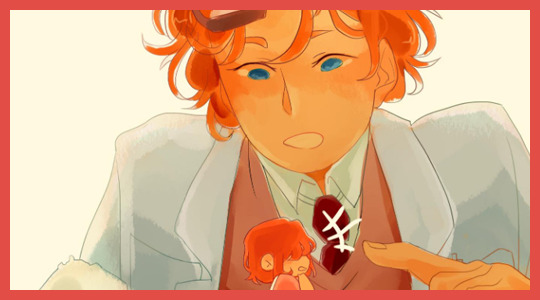
image source: [X] Why do you prefer traditional over digital? (or viceversa) I get to explore colours more easily without having to worry about soaking the paper, mixing wrongly, or even running out of supplies! What do you think is the most challenging part about being a traditional/digital artist? In the beginning there's definitely the transition to smoothly using digital art! It takes a while to use it so comfortably and freely that your digital sketches have the same life as your traditional ones, which I think is why some people still make their sketches on paper and transfer it over to finish in digital! What inspires your pieces? Feelings! They're very momentary and hard to accurately remember so I suppose finding ways to capture them and package them in a picture is a very strong inspiration for me ◝(●˙꒳˙●)◜
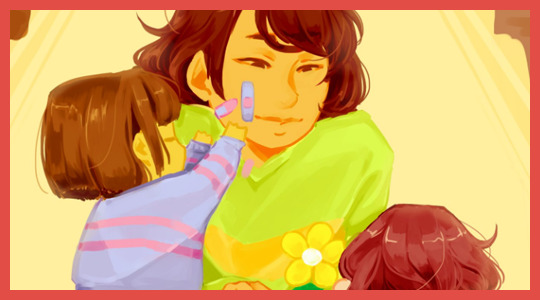
image source: [X] Explain your "everyday" drawing process I begin from a vague idea of the general feeling of a piece and the elements that should be in it, eg. the feeling of wonder + grass being pushed by the wind + some flowers at the side Then I just throw around some sketches of how to arrange these elements and what colours I could use! I make tweaks and when it seems nice enough I merge the sketch and colour layer and just start painting from there! Eventually I'll settle on what seems to be the finished piece and I adjust the colours and details again before properly saving it as a flat image! Do you have an artist you admire (or more than one)?
Oh I have a few! My favourites so far are:rollround ( https://twitter.com/rollround ) Cheryl's colours just make everything look so fun and alive! The way everything is both so detailed and comfortably simplistic/soft just speaks to my heart! I look forward to their prints the most every time I go to an artist alley!PlanetarianPwes ( https://instagram.com/planetarianpwes ) Pwes' faces and the way they use watercolours is just so good, and their OCs and AUs have such good stories behind them and the most interesting and varied designs I've seen! Following along with their characters' journeys shows you just how good their storytelling through their AUs is! I admire the most how they can manage to convey not only atmosphere but narrative as well!vi-6w6 ( https://vi-6w6.tumblr.com ) Annie's art was basically my role model in my early art years since I'm always in awe of how energetic and dynamic they are! Just her style and the way she lays down lines alone is enough to make even a static pose feel alive!tc2oh ( https://twitter.com/tc2oh ) Semi's colours and comics are amazing! The way they choose colours to make things look almost holographic at times, and just their general colour sense is my favourite thing! Even without that, their lineweights make their artwork stand out even in their comics! Also they draw lips so so good! I fell in love first in semi's comic (bomic) which is on line webtoon! Is there an artwork you are most proud of? Why? Yes! this guy ( https://twitter.com/lemonsqueazie/status/1118126304698613762 ) was actually made when I was switching art programmes to krita and finally got the hang of it! It's also the piece that got me out of my mini art-block at the time, I think!
Do you listen to music (or tv shows/films/anything else) when drawing? I usually just let youtube autoplay take me around a bunch of popular Japanese songs and artists like eve and kenshi yonezu and recently kamiyama you, and also the occasional utaite! Otherwise I go to find some friends' playlists or use my own (which is literally just a giant collection of things ranging from kazoo covers (you know the ones) to musicals and live concerts), I'm not all that picky!
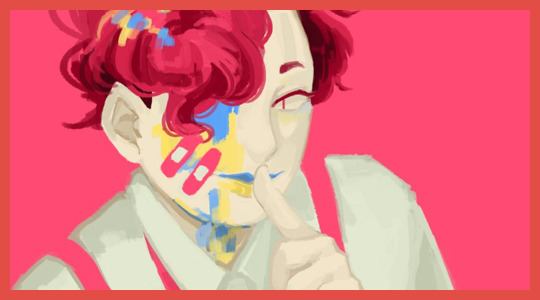
image source: [X] What makes art interesting for you? At its most basic it gives my hands something to do and that's always nice, but being able to create something that can always continue to exist and hold so much meaning that can keep changing is really neat, I think! What do you do when art block strikes? My main go-to is to switch mediums for a while (eg. going back to traditional, or even grabbing art materials I haven't used in a while, or switching programmes, or trying out new brushes) before going back to what I needed to finish! But recently I've been trying to focus on what's been causing the art block: eg. If I'm frustrated with drawing faces, I doodle a bunch of faces in a different and more indulgent way than I usually do before going back to what I was doing!If the problem is getting motivation to start, I watch speedpaints! Seeing how something so beautiful can start from absolutely nothing and work its way through to completion is my favourite thing ♡ What’s the most valuable art advice you’ve ever received?
"Aim to finish" or something along those lines! It was for a design project of sorts, but it's one of the most important things I need to take into account more often ( ´•̥̥̥ω•̥̥̥` ) especially in zine work! Oftentimes I can't pinpoint when the work is complete and is better to leave as-is and I'm working on finding and planning completion points too!
2 notes
·
View notes
Text
Demonstration of technical and visual skills – materials, techniques, observational skills, visual awareness, design and compositional skills.
I found four paintings by different artists using different styles and made sketches of these in soft pastels, the originals being oils, acrylics, and woodblock print. I translated these, adhering to a differentiating extent to the key approaches used by the four artists: stylised and linear (Hokusai’s The Great Wave [~1829]), blended (Turner’s Fishermen upon a Lee shore in Squally Weather [1802] ), naïve and almost abstract (Klee’s Golden Fish [1925]), and gesturally expressive (Hambling’s Bold Breaking waves series [~2012]). I began then to consider texts that might be relevant to each one and to look at typographic art, some of which I’d seen in a gallery in Brighton earlier. I was drawn back, though, to a poem I’d read by Marianne Moore called The Steeple jack (~1930) in which she writes, “Durer would have found a reason for living in a town like this … with eight stranded whales to look at.” I could not reconcile this with the art work I had chosen and nor could I see how I could use text in the very sophisticated way I had observed, a graphic rather than a drawing/painterly skill set.
As a result, I found myself deviating from my original plan and went on to work on sketches applying the different styles to reference photographs driven by sea scenes and whales. These I eventually amalgamated into one A1 image in which the four styles were represented in different areas. Finally, after a number of iterations at A1 size and some experiments at A2 portrait format, I developed the submission piece (A1 landscape) as a coherent whole but with small details that, for me, acknowledge the less foregrounded styles. As part of the process of composing the eventual image, I used the Fibonacci spiral to find the ‘golden ratio’ focal point then, using cut-outs from elements of earlier large scale sketches that I had printed out, found the placements and spaces I wanted.
The submission in its final form comprises images based on photographs of an exemplar of a huge wave in the north Atlantic, and whales surfacing to feed. The whole owes its expressiveness to Hambling’s energetic style, blended areas of foam to Turner, and some details in both the sweep of the wave and the foam to Klee and Hokusai. The large expanse of black gesso is unadulterated beyond a detail of dark red wash and is, for me, a triumph of leaving things alone instead of filling them up. Gesso is both textured and reflective so its surface changes depending on lighting and angle of view. For me, this seems to indicate that it is not a neglected unfinished space but one with its own dark movement and content.
Quality of outcome – content, application of knowledge, presentation of work in a coherent manner, discernment, conceptualisation of thoughts, communication of ideas.
This task permitted the use of any medium on any support of any size and I think it’s telling that, despite developing a fondness for soft pastels, I chose acrylics which would permit the large scale (A1) gestural marks I felt at least parts of the eventual piece merited. I wanted the height of the wave to be emphatic and the several iterations of the piece, including two I portrait orientation, were often about the position and relative size of the whales such that they would emphasise the scale by complementing each other. People know how big whales are and so if these were recognisable as such, the size of the wave is inescapable.
I have shown the evolution of the final piece in my contemporaneous blog posts where each image and associated discussion appears as a developmental stream, moving from the initial direct copying through the application of the individual styles to reference images and then to the eventual amalgamation of elements and blurring of styles. This was unplanned but grew, I believe, out of experimentation and productive extension of the principles of homage and progression.
Demonstration of creativity – imagination, experimentation, invention, development of a personal voice.
I really valued the copying process and I want to do more as it made me zoom in mentally to the techniques of the individual artists and what made them different. But I was also anxious not to attempt replication, not just because I lack the skills but because I am not those artists and developing my own voice is important. Amalgamation led to some backgrounding of the styles drawn from Hokusai and Klee as these did not sit well with the other two which I found could merge along their edges and in pockets within each other. In essence though, the piece travels right to left from Hambling-esque to Turner-esque with dots of reference to Klee and Hokusai within that broad area.
There are parts I like more than others; the leading edge of the wave for instance, and the turbulence around the whales. I have cropped these and put them in a folder accessed by my Echo Show devices which is a method I use to distance myself from a piece of work and see it as nearly as possible the way someone else might, and they still please me. I am less sure of some of the other parts, including the expanse of sea/sky on the left although I think that serves to balance the energy of the rest.
An intriguing observation is that I felt very present in this image; cold and small in the freezing environment I was trying to make. Is that the voice I’m trying to find? Being there in the image as I am when I write? Perhaps it’s an essential, and hopefully I will develop in time the skills and techniques to begin to do that justice.
Context reflection – research critical thinking (as evidenced in learning log).
I am not sure what to say here beyond the shock of finding copying the styles of four different artists using different media, different supports, and most likely a different dominant hand something I could do sufficiently well to feel I had accomplished something important in learning how art works. This was a revelation and I intend to do more of what I’m seeing as ‘copies+’ – someone else’s design, my interpretation or slant. I am beginning to understand a little of the debate about representation and what second order art work might be via the materials for UVC (2016) which I dropped as a qualifying course but still have available to read. But I’m not sure what term might apply to the use of an original representation re-presented in a different style.
My research I would define as exploration of different media – inks, soft pastels, acrylics, pen and brush, and devices to scratch at a surface to allow layers beneath to show or to give ink a channel into which to accumulate. I also went back to my original idea of four small pieces in different styles, illustrating a stanza from The Steeplejack, and made a series of drawings in inks and pastels on a piece of A3 watercolour paper, incorporating the text itself. Researching typographic art, I saw how sophisticated and graphics-driven it appeared to be, the lettering inventive and tailored but very precise so as to be clearly the vehicle for the image. What I produced is a essentially a prototype, an idea that requires its own process to develop for which I am not at all equipped.
Hokusai, K. The Great Wave off Kanagawa (1829-1833). The Met Museum
Turner, J.M.W. Fishermen on a Lee-shore in Squally Weather, (c 1802) Southampton City gallery.
Klee, P. The Golden Fish [also The Gold Fish] (1925). Paulklee.net
Hambling, M. image selected from the series Bold Breaking Waves (c 2012). My Modern Met.
Moore, M. (1932) The Steeple Jack. The Poetry Foundation.
All sites last accessed 18/01/2020.
Typographic art
https://mymodernmet.com/what-is-typography-definition/ This was the first set of examples of typography art I found and the quality is such that I realised I would be unable to produce anything remotely satisfying. Site accessed 17/01/2020.
https://www.pinterest.co.uk/heart58/typographic-artwork/ This is an annotated Pinterest collection with a wide variety of types, styles, and artists. Site accessed 17/01/2020.
Discussion of representation, resemblance, nesting, meta painting, and auto/allographics attributed to Michael Belcham, author of Understanding Visual Culture course materials, OCA 2016 pp 72-75
Blog posts
Part 5 – personal project preparatory work, digital seas
Part 5: personal project – introduction
Part 5: task remit, artist statement, supporting images – first thoughts
Part 5 – personal project, sketches and ideas #1
Part 5 – personal project; sketches ideas #2
Part 5: Personal project – expanding on sketches #3
NB I may edit this post prior to submission, but will not do so subsequently.
Part 5 self evaluation Demonstration of technical and visual skills - materials, techniques, observational skills, visual awareness, design and compositional skills.
0 notes
Text
It is my great pleasure to introduce readers to British artist Michele Clamp, scientist turned watercolourist.
The Interview
Who are you and what do you do?
My name is Michele Clamp and I am a watercolour artist.
Why do you do what you do?
I am tempted to reply ‘Because I can’. If you had the opportunity to create beautiful things that reflect who you are as a person and how you see the world why wouldn’t anyone? But maybe that’s too glib an answer. On a day to day basis painting simply makes life worth living. Even when the work goes badly (as it often does) it is still worthwhile. Painting is difficult, frustrating, unpredictable, and often not taken seriously by many. And objectively I am unlikely to go down in art history and sometimes it seems unlikely I’ll make a living at it. But none of that detracts from the satisfaction of setting your brushes down at the end of the day with something new on the easel. If, as I am lucky to have happen, other people want to take your work into their homes and it gives them pleasure in their lives so much the better.
Hare Today. Michele Clamp. Watercolour 14”x11”
Rose-breasted grosbeak. Michele Clamp. Watercolour 14”x11”
How do you work?
Regularly. That’s the main thing. I have a routine – go upstairs to the studio, put the lights on, put the radio on. Open the palette, top up any colors that are running low. Arrange the brushes and get the water pot filled with fresh water. Tape a fresh piece of paper to the empty board resting on the easel. It’s almost a ritual and it’s necessary. I am then in the right frame of mind to prod around in my subconscious to find out what I am itching to do.
As I am a watercolour painter and paint quickly I almost always complete a painting in a single session. This creates a lot of forward momentum as the weeks go by and I can move from subject to subject quickly. Other times I’ll work in series over a month or so. It could be birds one month, cityscapes another.
Even if a brush isn’t put to paper on any given day ideas are bubbling through my mind. These could be ideas for subject matter, design or style. A big portion involves reflecting on past works that may or may not have succeeded. What do I like, want don’t I like. Did I capture the light or the mood? Did it capture something about the moment that I didn’t expect and can I build on that.
Cockwomble. Michele Clamp. Watercolour 11”x14”
Puffins. Michele Clamp. Watercolour 11”x14”
What is your background?
Like many artists my interest was sparked in childhood. My father was a talented amateur artist when he was young but only had a limited amount of time to spend on it when I was a child. Even so I remember sitting beside him as he sketched outside. I had my own small sketchbook and tried to learn from him as he drew landscapes in the Essex countryside, marking in color and lighting notes as he went. These were intended to be preparatory sketches for larger oil paintings but sadly these almost never came to pass. However, I had almost no detectable talent at that point. My mother is still incredulous that I’ve ended up painting as she often remarks how bad I was in those years. It turned out that the art bug didn’t bite me hard until I was about 13. Somehow something clicked in a school art lesson. Mrs Amner our art teacher had put a group of us in front of a huge old mechanical typewriter and we were instructed to draw it. Not an easy subject for us but the longer I looked the more the complex mechanical shapes made sense and my pencil followed suit. I’d discovered the pleasure of truly seeing something and representing it on paper.
I loved painting and drawing throughout the rest of my school years and did them both in parallel with science and maths. When it came to deciding on college I plumped for science and went on to do a degree in physics at Oxford followed by a PhD. Art was on the back burner for many years. I had a wonderful career in science and worked in many interesting areas including the Human Genome Project. My science career took me from Oxford to Cambridge to MIT and Harvard and I was extremely lucky to be part of the genomics revolution over the past couple of decades.
I always knew I’d come back to art at some point although I didn’t know when. It’s little appreciated that science is a hugely creative endeavor. Like art it’s also all-consuming – you can’t dabble and expect to do it well. So after emerging 5 years ago from immersion in the research world I needed a creative outlet again. And watercolour was there waiting.
From 2012 to the end of last year I balanced painting with working. This year, however, we bit the bullet, quit our jobs and I get to paint full time. It’s bliss.
Sunflowers. Michele Clamp. Watercolour 11”x14”
Brass callipers. Michele Clamp. Watercolour 14”x11”
What is integral to the work of an artist?
Ah. There’s a quote about science by the famous physicist Richard Feynman that pops into my mind here. ‘The first principle is that you must not fool yourself and you are the easiest person to fool.’ So honesty, humility, and at least an attempt to keep the ego on a short leash.
What role does an artist have in society?
Wow. That’s a biggie.
What has been a seminal experience?
These are all hard questions but this one stumped me for a long while. I have to admit that I am not one of those artists that hate everything they do. Not that I’m uncritical (not at all) but I’m usually pretty positive about the work I produce. Very rarely does something emerge that is totally worthless in my eyes. I am self-aware enough to realise that I am hugely biased and lucky enough that I don’t need huge amounts of external validation. A year after I had returned to painting, however, something happened that made me think this wasn’t just an activity to please me. I used to go to a lot of classes at the local adult education centre in Cambridge, Mass. and they’d regularly run shows with students work. When I’d been painting for about a year I managed to get 8 pieces into their summer show. I’d put prices on them but really had no expectations in that area. When I arrived at the opening I was astounded that 3 had already sold. As the evening went on 3 more sold and I was emailed by someone later to buy another one. One painting was so popular the organisers emailed me to ask if I had anything similar as they’d had so many requests. It gave me huge confidence that this wasn’t just a solo journey.
Trinity College, Oxford. Michele Clamp. Watercolour 14”x11
Baptist Church, Marlborough, MA. Michele Clamp. Watercolour 14”x11”
How has your practice changed over time?
The big thing was understanding how important just showing up is.
What art do you identify most with?
We live in a very noisy world. So shouty art is not my thing. Art that screams at you and grabs you by the lapels is not for me. I like art that slowly gets under your skin. Art that creeps up on you over a period of time. Art that you come back to after years away and go ‘Ah yes now I get it’. Subtlety, nuance, layers, longevity. I’m British – what do you expect?
What work do you most enjoy doing?
Oh that’s easy – good work. Definitely good work. Seriously though it’s easier to answer that by thinking about the work I don’t enjoy doing. And that is work that I do when I start taking myself too seriously. Stuff that I plan when things are going well and I think I’m really getting to the next level. I get really ambitious and start large complicated paintings and work really hard and all the fun goes out of it. I start fooling myself in other words. I learned early on that your really good work comes from painting what you want to paint. However you don’t consciously choose what you want to paint – it comes from somewhere below the surface and it takes practice to let that side of yourself free.
Sunlit. Michele Clamp. 11”x14”
Liberty Boat. Michele Clamp. Watercolour 11”x14”
What is your favourite artwork?
That is far too difficult a question to answer. If I absolutely had to pick one it would be John Sell Cotman’s Chirk aqueduct. It’s a watercolour (of course) and I first came across it as a kid in one of my parent’s art books. It has everything I love – subtle colors, strong design and I enjoy it a little more every time I come across it. The composition is slightly off kilter – it looks as though it doesn’t quite fit on the page. It’s a little disconcerting the first few times you come across it but it’s that little bit of quirkiness that offsets the restrained colors and apparent lack of action.
Is the artistic life lonely? What do you do to counteract it?
Hmm. Is it any lonelier than all the corporate nonsense I’ve had to deal with elsewhere? Performance reviews, 360 assessments, endless pointless meetings, snotty emails, deadlines and justifications? Nope, not really. Just don’t look at the bank balance.
Hethersett Church, Norfolk UK. Michele Clamp. Watercolour 8”x10”
What is the best piece of advice you have been given?
A few months after I’d started painting again regularly I was showing someone photos of what I’d been doing on my phone. I was still feeling my way but some were good, some not so good, but there was definitely something worthwhile there. On one photo they stopped – it was a quick watercolour still life sketch. I’d managed to do something with lush colour and broad brushstrokes and it had confidence and ease and energy. ‘Oh Michele’ they said, ‘If only you could live your life the way you paint’. That comment has always stayed with me.
What wouldn’t you do without?
My husband James Cuff. Constantly supportive and encouraging even when things aren’t going well. And makes a mean gin and tonic.
Thank you for the insightful interview Michele. To see more of Michele’s work please contact her on the details below.
Website : micheleclamp.com
For Sale: micheleclamp.com/paintings-for-sale
Instagram: @micheleclamp
Email: [email protected]
Facebook: MicheleClampArt
Beauty, one brushstroke at a time.
Artist Interview: Michele Clamp It is my great pleasure to introduce readers to British artist Michele Clamp, scientist turned watercolourist.
0 notes
Text
It is my great pleasure to introduce readers to British artist Michele Clamp, scientist turned watercolourist.
The Interview
Who are you and what do you do?
My name is Michele Clamp and I am a watercolour artist.
Why do you do what you do?
I am tempted to reply ‘Because I can’. If you had the opportunity to create beautiful things that reflect who you are as a person and how you see the world why wouldn’t anyone? But maybe that’s too glib an answer. On a day to day basis painting simply makes life worth living. Even when the work goes badly (as it often does) it is still worthwhile. Painting is difficult, frustrating, unpredictable, and often not taken seriously by many. And objectively I am unlikely to go down in art history and sometimes it seems unlikely I’ll make a living at it. But none of that detracts from the satisfaction of setting your brushes down at the end of the day with something new on the easel. If, as I am lucky to have happen, other people want to take your work into their homes and it gives them pleasure in their lives so much the better.
Hare Today. Michele Clamp. Watercolour 14”x11”
Rose-breasted grosbeak. Michele Clamp. Watercolour 14”x11”
How do you work?
Regularly. That’s the main thing. I have a routine – go upstairs to the studio, put the lights on, put the radio on. Open the palette, top up any colors that are running low. Arrange the brushes and get the water pot filled with fresh water. Tape a fresh piece of paper to the empty board resting on the easel. It’s almost a ritual and it’s necessary. I am then in the right frame of mind to prod around in my subconscious to find out what I am itching to do.
As I am a watercolour painter and paint quickly I almost always complete a painting in a single session. This creates a lot of forward momentum as the weeks go by and I can move from subject to subject quickly. Other times I’ll work in series over a month or so. It could be birds one month, cityscapes another.
Even if a brush isn’t put to paper on any given day ideas are bubbling through my mind. These could be ideas for subject matter, design or style. A big portion involves reflecting on past works that may or may not have succeeded. What do I like, want don’t I like. Did I capture the light or the mood? Did it capture something about the moment that I didn’t expect and can I build on that.
Cockwomble. Michele Clamp. Watercolour 11”x14”
Puffins. Michele Clamp. Watercolour 11”x14”
What is your background?
Like many artists my interest was sparked in childhood. My father was a talented amateur artist when he was young but only had a limited amount of time to spend on it when I was a child. Even so I remember sitting beside him as he sketched outside. I had my own small sketchbook and tried to learn from him as he drew landscapes in the Essex countryside, marking in color and lighting notes as he went. These were intended to be preparatory sketches for larger oil paintings but sadly these almost never came to pass. However, I had almost no detectable talent at that point. My mother is still incredulous that I’ve ended up painting as she often remarks how bad I was in those years. It turned out that the art bug didn’t bite me hard until I was about 13. Somehow something clicked in a school art lesson. Mrs Amner our art teacher had put a group of us in front of a huge old mechanical typewriter and we were instructed to draw it. Not an easy subject for us but the longer I looked the more the complex mechanical shapes made sense and my pencil followed suit. I’d discovered the pleasure of truly seeing something and representing it on paper.
I loved painting and drawing throughout the rest of my school years and did them both in parallel with science and maths. When it came to deciding on college I plumped for science and went on to do a degree in physics at Oxford followed by a PhD. Art was on the back burner for many years. I had a wonderful career in science and worked in many interesting areas including the Human Genome Project. My science career took me from Oxford to Cambridge to MIT and Harvard and I was extremely lucky to be part of the genomics revolution over the past couple of decades.
I always knew I’d come back to art at some point although I didn’t know when. It’s little appreciated that science is a hugely creative endeavor. Like art it’s also all-consuming – you can’t dabble and expect to do it well. So after emerging 5 years ago from immersion in the research world I needed a creative outlet again. And watercolour was there waiting.
From 2012 to the end of last year I balanced painting with working. This year, however, we bit the bullet, quit our jobs and I get to paint full time. It’s bliss.
Sunflowers. Michele Clamp. Watercolour 11”x14”
Brass callipers. Michele Clamp. Watercolour 14”x11”
What is integral to the work of an artist?
Ah. There’s a quote about science by the famous physicist Richard Feynman that pops into my mind here. ‘The first principle is that you must not fool yourself and you are the easiest person to fool.’ So honesty, humility, and at least an attempt to keep the ego on a short leash.
What role does an artist have in society?
Wow. That’s a biggie.
What has been a seminal experience?
These are all hard questions but this one stumped me for a long while. I have to admit that I am not one of those artists that hate everything they do. Not that I’m uncritical (not at all) but I’m usually pretty positive about the work I produce. Very rarely does something emerge that is totally worthless in my eyes. I am self-aware enough to realise that I am hugely biased and lucky enough that I don’t need huge amounts of external validation. A year after I had returned to painting, however, something happened that made me think this wasn’t just an activity to please me. I used to go to a lot of classes at the local adult education centre in Cambridge, Mass. and they’d regularly run shows with students work. When I’d been painting for about a year I managed to get 8 pieces into their summer show. I’d put prices on them but really had no expectations in that area. When I arrived at the opening I was astounded that 3 had already sold. As the evening went on 3 more sold and I was emailed by someone later to buy another one. One painting was so popular the organisers emailed me to ask if I had anything similar as they’d had so many requests. It gave me huge confidence that this wasn’t just a solo journey.
Trinity College, Oxford. Michele Clamp. Watercolour 14”x11
Baptist Church, Marlborough, MA. Michele Clamp. Watercolour 14”x11”
How has your practice changed over time?
The big thing was understanding how important just showing up is.
What art do you identify most with?
We live in a very noisy world. So shouty art is not my thing. Art that screams at you and grabs you by the lapels is not for me. I like art that slowly gets under your skin. Art that creeps up on you over a period of time. Art that you come back to after years away and go ‘Ah yes now I get it’. Subtlety, nuance, layers, longevity. I’m British – what do you expect?
What work do you most enjoy doing?
Oh that’s easy – good work. Definitely good work. Seriously though it’s easier to answer that by thinking about the work I don’t enjoy doing. And that is work that I do when I start taking myself too seriously. Stuff that I plan when things are going well and I think I’m really getting to the next level. I get really ambitious and start large complicated paintings and work really hard and all the fun goes out of it. I start fooling myself in other words. I learned early on that your really good work comes from painting what you want to paint. However you don’t consciously choose what you want to paint – it comes from somewhere below the surface and it takes practice to let that side of yourself free.
Sunlit. Michele Clamp. 11”x14”
Liberty Boat. Michele Clamp. Watercolour 11”x14”
What is your favourite artwork?
That is far too difficult a question to answer. If I absolutely had to pick one it would be John Sell Cotman’s Chirk aqueduct. It’s a watercolour (of course) and I first came across it as a kid in one of my parent’s art books. It has everything I love – subtle colors, strong design and I enjoy it a little more every time I come across it. The composition is slightly off kilter – it looks as though it doesn’t quite fit on the page. It’s a little disconcerting the first few times you come across it but it’s that little bit of quirkiness that offsets the restrained colors and apparent lack of action.
Is the artistic life lonely? What do you do to counteract it?
Hmm. Is it any lonelier than all the corporate nonsense I’ve had to deal with elsewhere? Performance reviews, 360 assessments, endless pointless meetings, snotty emails, deadlines and justifications? Nope, not really. Just don’t look at the bank balance.
Hethersett Church, Norfolk UK. Michele Clamp. Watercolour 8”x10”
What is the best piece of advice you have been given?
A few months after I’d started painting again regularly I was showing someone photos of what I’d been doing on my phone. I was still feeling my way but some were good, some not so good, but there was definitely something worthwhile there. On one photo they stopped – it was a quick watercolour still life sketch. I’d managed to do something with lush colour and broad brushstrokes and it had confidence and ease and energy. ‘Oh Michele’ they said, ‘If only you could live your life the way you paint’. That comment has always stayed with me.
What wouldn’t you do without?
My husband James Cuff. Constantly supportive and encouraging even when things aren’t going well. And makes a mean gin and tonic.
Thank you for the insightful interview Michele. To see more of Michele’s work please contact her on the details below.
Website : micheleclamp.com
For Sale: micheleclamp.com/paintings-for-sale
Instagram: @micheleclamp
Email: [email protected]
Facebook: MicheleClampArt
Beauty, one brushstroke at a time.
Artist Interview: Michele Clamp It is my great pleasure to introduce readers to British artist Michele Clamp, scientist turned watercolourist.
0 notes